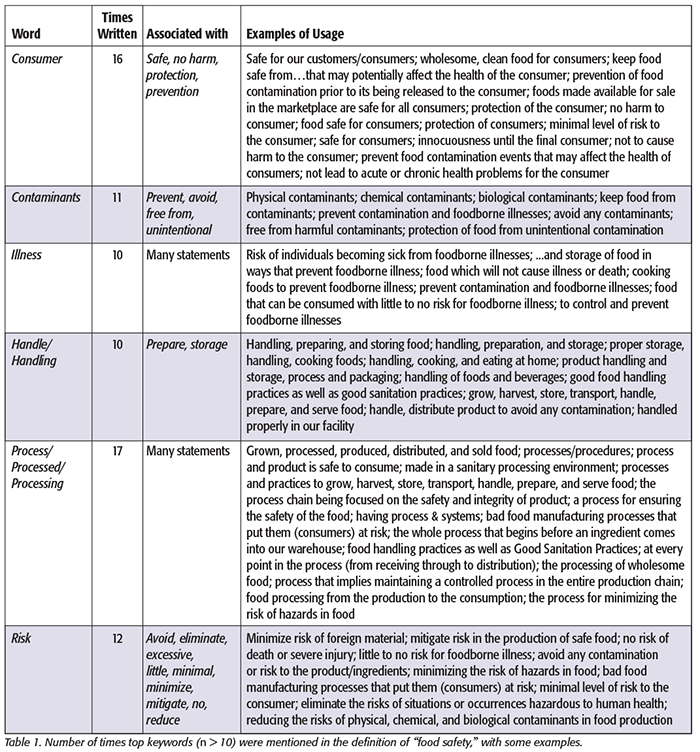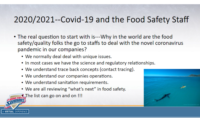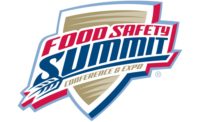There is no consistent, or accepted, definition of “food safety,” and this term appears to have different meanings among the public and even among food safety professionals. We are aware of the lack of a working definition of food safety among food safety professionals and individuals working with foods, and this limitation may become a barrier to how food safety professionals communicate the concepts of food safety to the public. (When we use food safety in quotation marks or italics, we’re referring to the term; otherwise, we’re referring to the concept of food safety.)
In a previous edition of Food Safety Magazine’s eDigest,[1] we reported the results of a survey assessing the most commonly selected definition of “food safety,” from a predetermined set of answers, by food manufacturers, food inspectors (state and federal), and other food safety professionals who participated in food safety training or lectures provided by the University of Vermont (UVM) Extension. The choices of answers included all responses to a published survey,[2] in which 5,000 consumers nationwide and executives from 40 retail companies were surveyed to assess, among other things, their selection of what attributes are the most representative in the definition of “food safety.”
Our findings showed that, given specific predetermined answers, the most common definitions chosen were “free of harmful elements” and “none of the above” to describe their interpretation of “food safety.” We have reasoned that, although appealing as a definition of “food safety,” the response “free of harmful elements” does not represent good manufacturing practices on how food is manufactured around the world.[1] Yet, the selection of no specific response indicates more research is needed to provide a more comprehensive list of options for defining the concept of food safety.
At a food safety meeting, while discussing the current limitations on how people understand and define food safety, we decided to organize a survey of individuals working with foods to collect the definitions of “food safety” and report the findings to the audience of Food Safety Magazine. Thus, UVM Extension and Food Safety Magazine organized an online survey to collect information on the current understanding of the term “food safety” among food industry professionals.
Initially, the survey was sent to a selected group of individuals for feedback on the questions and response options. The survey was then modified and restructured to have 10 questions on demographics, in which participants willingly provided information that included residence location, occupation, age, education level, and the number of years working with foods. At the end of the survey, there was an open-ended question that asked participants to provide their definitions of food safety. Participation was voluntary and all answers were kept confidential.
The survey was distributed through the email contact lists of the authors and through postings on the website of Food Safety Magazine. We targeted primarily food manufacturers and food professionals for the survey. Survey responses were collected between March 19, 2019, and May 20, 2019. The survey was posted through the LimeSurvey system of UVM. Participants received an email with a link to the survey to complete the survey online.
Results
We received a total of 159 responses. However, 76 were incomplete because participants started the survey but never completed the final submission. From 83 full responses, two were related to animal feed and pet food; therefore, they were removed from this study, which focused on the definition of food safety applied to human food. Thus, 81 responses matched the criteria of being full responses submitted by the individual completing the survey.
The analysis of the demographics data showed that 54 percent of the respondents were from the U.S., and the rest were from Canada, Colombia, Dominican Republic, El Salvador, France, Guatemala, Peru, Switzerland, The Netherlands, and the United Kingdom. Thirty-three percent of the respondents were in senior management positions (owners, directors, and managers), whereas the remaining respondents work in retail (44%), are processors (12%), or work as consultants (16%).
Other key characteristics of the population of respondents included:
• 72% of all respondents were between the ages of 31 and 60
• 61% of the respondents have worked at least 11 years
Regarding the highest education level attained by participants, 62 percent of respondents had an M.Sc./M.A. degree or higher educational level. Within food safety training, 30 percent had Hazard Analysis and Critical Control Points training, and 24 percent had Preventive Controls for Human Food (Food Safety Modernization Act) training. In general, survey participants selected a variety of food types with which they work.
Our overall analysis of the demographic data shows a large percentage of participants have been working for the food industry for several years, have advanced degrees and food safety training, and have daily responsibilities related to food safety activities.
The definitions of food safety provided by survey participants included multiple words and terms. In 20 percent of the cases, the definition provided included the term “food safety” and described the end results of food safety, such as:
• The presentation of food that can be consumed with little to no risk for foodborne illness, either chronic or acute
• Taking actions that ensure safer food
• No harm to consumer of the food
• Keeping food safe for consumers
• The biological, chemical, or physical status of a food that will permit its consumption without incurring excessive risk of injury, morbidity, or mortality
• Food that cannot cause any type of damage
• Food I can trust!
• Food that is consistently safe for consumers of all ages, health, anywhere in the world
• The quality of the food not to cause harm to the consumer
• Possibility that every person has safe food from the point of view of safety, nutrition, and energy
• Protecting public health
 We grouped the definitions collected based on keywords that were repeated across responses. These keywords were based on their association with or relationship to “safe.” Table 1 shows a selected number of keywords that appear multiple times in the definitions submitted by survey participants.
We grouped the definitions collected based on keywords that were repeated across responses. These keywords were based on their association with or relationship to “safe.” Table 1 shows a selected number of keywords that appear multiple times in the definitions submitted by survey participants.
Within the group of words that appear more than 10 times, the word consumer appeared 16 times (20%) and was associated with the words safe, no harm, protection, prevention. It appears that survey participants recognize the importance—and in these days the legal implications—of food that may harm consumers. The word contaminants appears 11 times (14%) and was associated with avoid, free, and prevent.
The words illness and handle or handling appeared each 10 times (12%). The words process, processed, or processing appeared 17 times (21%) and in many different sentences. The word risk appeared 12 times (15%) and was associated with avoid, eliminate, excessive, little, minimal, minimize, mitigate, and reduce.
The words eliminate and elimination appeared only three times and in association with hazards. The word free appeared only five times (6%), highlighting a major contrast with our previous survey, in which participants could only choose out of a predetermined set of answers. The word free was associated with harmful organism, harmful contaminants and diseases, foreign or extraneous materials, organisms of public health concern, and undeclared allergens.
In some cases, the definitions appear to refer to practices that result in safe foods, such as:
• To guarantee, through inspection, surveillance, and sanitary control actions with a risk approach, the safety of the food that is commercialized, or
• Food safety is everything people involved in food processing from the production to the consumption do to have food that does not produce harm when it is consumed, or
• Food safety is the set of practices that are implemented in a company in order to prevent food contamination events that may affect the health of consumers.
The word “quality” was mentioned in seven responses (9%). Two responses focused on food security (accessibility to quality, safe food), while three responses hinted at a link between quality and safety, where quality provides safety. Those definitions were:
• “Food safety” refers to the conditions and practices that preserve the quality of food to prevent contamination and foodborne illness.
• “Food safety” includes quality and safety through the whole food chain.
• The quality of the food not to cause harm to the consumer.
In two out of nine responses, survey participants did not assume a correlation between quality and safety. In these cases, the definitions were:
• Set of policies and strategies to guarantee quality, nutritional value, and food safety.
• They are the different processes and strategies that are carried out by producers, manufacturers, marketers, and the state to ensure that the food and beverages produced are safe, nutritious, and of quality.
The findings from our survey are of interest because it appears that personnel working with food did not perceive quality as a determinant of safety, as has been shown to be the case when surveying the public. Both safety and quality have been grouped within “credence attributes,” meaning that the attributes that define quality or safety cannot be verified by the consumer.[3–5] Credence attributes are those that consumers cannot evaluate with confidence; therefore, consumers must rely on opinions with regards to the product itself or the producer.[6] Nelson[3] proposed that consumers perceive safety and quality from specific clues associated with the product itself, such as intrinsic or extrinsic attributes. Although visual cues can reinforce perceived quality aspects, safety is so abstract that consumers do not have any means to reinforce perceptions of food safety.
A study by van Rijswijk and Frewer[4] found that two-thirds of the participants from Germany, Italy, and Spain perceived food quality and food safety as interconnected concepts. For those participants reporting a strong relation between food quality and food safety, the safety of a product was inferred from the quality of the product, and not vice versa. In other words, when people perceived a product as being of good quality, they assumed that the product was also safe. Although food safety was primarily defined with terms such as absence of risk or harmfulness, and with a positive association with health, terms such as not risky/safety, risky/harmful, proper production method, proper handling, and healthy (no health risk) were shared for both the definition of “safety” and “quality.”
Most of the research in the area of perception of food safety has targeted consumers and has involved studies where both safety and quality were assessed. We don’t have similar surveys targeting food safety professionals and/or individuals working with food. As we improve our understanding of the science behind food safety, it appears necessary to determine whether the terms safety and quality are still perceived as interconnected. In our survey, the word quality was seldom used, and therefore individuals working with foods appear to have a clear separation of the attributes related to quality versus those related to safety.
In the last two decades, there have been increased efforts to improve food safety knowledge among consumers.[7] Yet, we know little of how food safety professionals and individuals working with food understand this term. The results from our survey highlight that there are common words that individuals working in the food industry use to define food safety. However, the actual definitions vary from simple ones, such as the process for minimizing the risk of hazards in food, or protecting public health, to longer definitions, such as:
Food is safe if the food at the moment of consumption under normal circumstances and in normal quantities will in general not lead to acute or chronic health problems for the consumer. Food with allergens [is] safe for the average consumer, but not those with allergies.
There were many definitions that included the words management, handling, practices, procedures, preparation, and/or manufacturing to describe food safety, and from a scientific standpoint, we know that food safety is improved by known practices that, when properly implemented, will lead to the manufacturing of safe food products most of the time. Some of these definitions were:
• Application of the art and science of handling, preparing, and storing food to best reduce the risk of individuals becoming sick from foodborne illnesses.
• Management and elimination of physical, chemical, and biological hazards inherent to grown, processed, produced, distributed, and sold food.
• Food safety is the prevention of food contamination prior to its being released to the consumer by ensuring that all foods made available for sale in the marketplace are safe for all consumers.
• My definition as it applies to my job as a food safety professional: Manufacturing foods that are safe to consume and that are made in a sanitary processing environment.
• The regulations, programs, policies, and procedures that ensure the safe production, packaging, distribution, and delivery of food.
• Ensuring manufactured and prepared food is safe to consume through a variety of controls throughout the supply chain.
• Food safety is a scientific discipline describing the safe processes and practices to grow, harvest, store, transport, handle, prepare, and serve food and food ingredients to prevent foodborne illness.
• All things related to the growing, harvest, production, and handling of foods and beverages that will not cause acute or chronic illness in humans or animals.
• Food safety is a way of life; it is how you store, handle, [and] distribute product to avoid any contamination or risk to the product/ingredients.
• The practices and protocols put in place to maintain the integrity of food products, ensuring that they are free from harmful contaminants and diseases, from farm to table.
Thus, it appears that the general definition of “food safety” that emerges from this survey could be summarized as: the production, manufacturing, processing, packing, or holding practices known to result in safe (wholesome) foods.
Because we targeted primarily food manufacturers, the survey has several limitations in its interpretation. Similar surveys, or in-depth interviews, could help verify whether a larger group of participants would provide similar responses. We also don’t know whether similar answers would be obtained from individuals working in primary food production, such as farms, or individuals who grow their own foods for consumption. In addition, the source of information could play an important role in how people define food safety. This is especially true when we know some players may amplify information on social media that may not correlate directly with what is known to impact food safety.
In summary, there were many definitions of food safety. Yet, the words management, handling, practices, procedures, preparation, and/or manufacturing were cited the most. Also, respondents did not perceive quality as a determinant of safety, departing from the results of previous surveys. Thus, more studies should be done to understand these variations in food safety definitions.
Omar A. Oyarzabal, Ph.D., is an associate professor of food safety at the University of Vermont.
Barbara B. VanRenterghem, Ph.D., is the editorial director of Food Safety Magazine.
References
1. www.food-safety.com/enewsletter/perception-of-food-safety-by-food-manufacturers-and-food-safety-professionals/.
2. www2.deloitte.com/content/dam/Deloitte/us/Documents/consumer-business/us-fmi-gma-report.pdf.
3. Nelson, P. 1970. “Information and Consumer Behavior.” J Political Econ 78:51–57.
4. Van Rijswijk, W and LJ Frewer. 2008. “Consumer Perceptions of Food Quality and Safety and Their Relation to Traceability.” Brit Food J 110(10):1034–1046.
5. Ortega, DL, et al. 2011. “Modelling Heterogeneity in Consumer Preferences for Select Food Safety Attributes in China.” Food Policy 36(2):318–324.
6. Verbeke, W and RW Ward. 2006. “Consumer Interest in Information Cues Denoting Quality,
Traceability and Origin: An Application of Ordered Probit Models to Beef Labels.” Food Qual Prefer 17(6):453–467.
7. Wilcock, A and B Ball, “Food Safety: Consumer Perceptions and Practices,” in Practical Food Safety: Contemporary Issues and Future Directions, eds. Bhat R and VC Gomez-Lopez (Chichester: John Wiley & Sons, Ltd, 2014).
The Meaning of Food Safety





